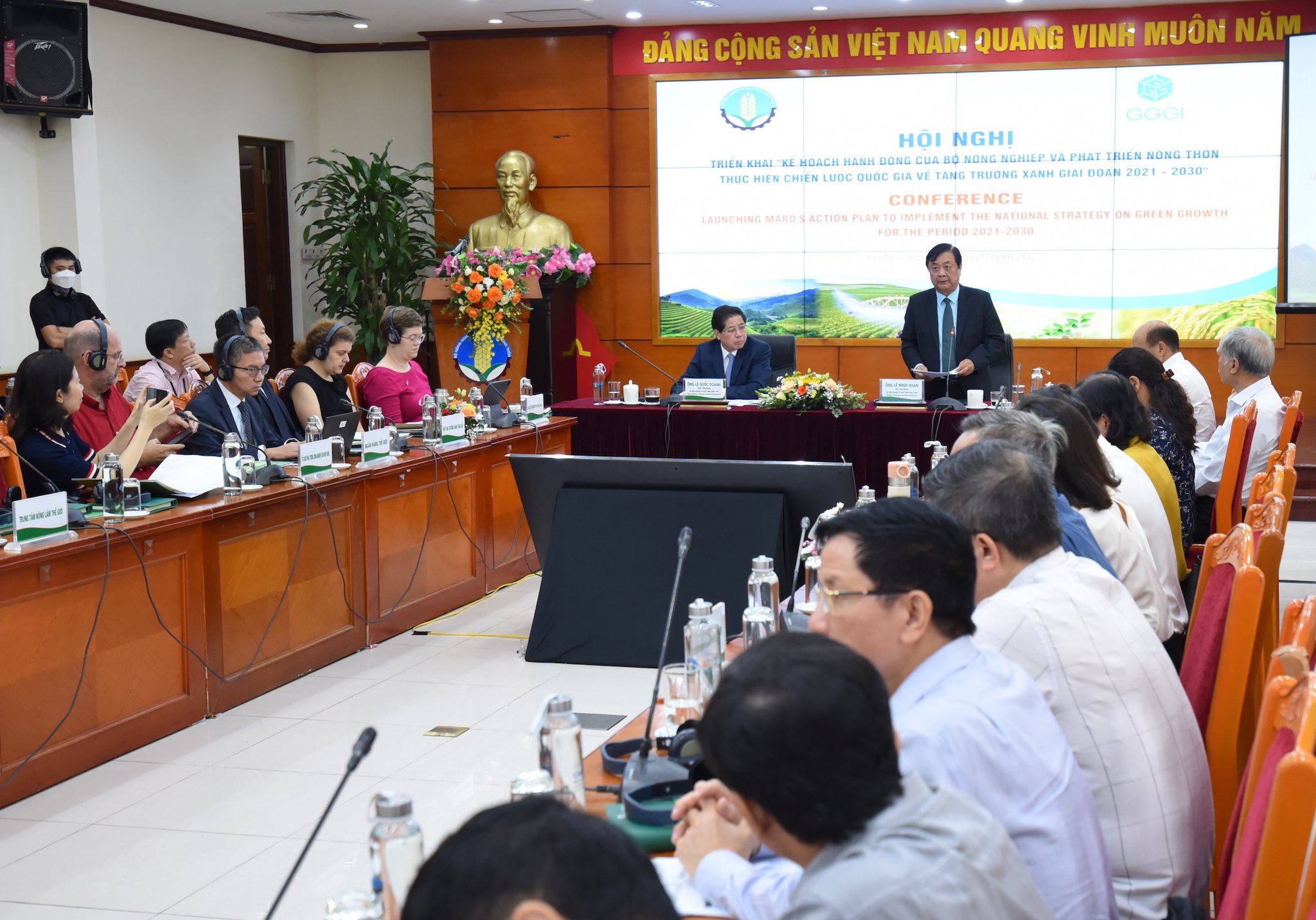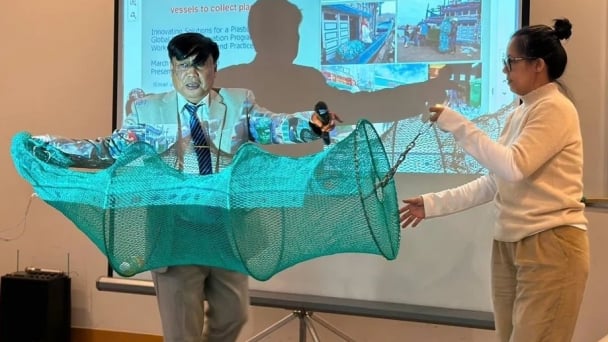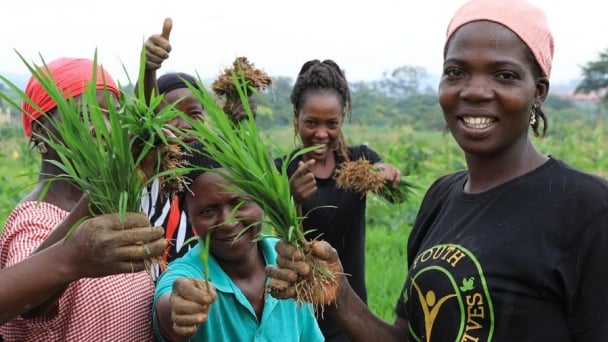May 14, 2025 | 15:20 GMT +7
May 14, 2025 | 15:20 GMT +7
Hotline: 0913.378.918
May 14, 2025 | 15:20 GMT +7
Hotline: 0913.378.918

Minister Le Minh Hoan and Deputy Minister Le Quoc Doanh chaired a conference on the implementation of the Action Plan of the Ministry of Agriculture and Rural Development following the 2021-2030 National Strategy on Green Growth on September 30. Photo: Tung Dinh.
On September 30, the Ministry of Agriculture and Rural Development (MARD) held a conference on the implementation of the Action Plan of the Ministry of Agriculture and Rural Development following the 2021-2030 National Strategy on Green Growth. The conference was chaired by Minister Le Minh Hoan and Deputy Minister Le Quoc Doanh and welcomed the attendance of many ministries, branches and international organizations.
Speaking at the opening of the conference, Minister Le Minh Hoan said that over the years Vietnam's agriculture had experienced continuous growth, developed comprehensively and achieved great results. Food production output has increased rapidly in terms of both quantity and quality, ensuring an abundant supply, meeting domestic consumption and export demand.
However, the leader of the agriculture sector also emphasized one fact: Vietnam's agriculture still faces many challenges, such as shrinking production areas, increasing demand for food due to population growth, and the lack of attention to sustainable development. “We have not thoroughly resolved the residues in animal feed, aquaculture, excessive use of inorganic fertilizers and chemical pesticides. The rate of post-harvest losses is still high, causing risks and danger to the environment.”
Given that green growth has gradually become a mainstream trend in the world, Minister Le Minh Hoan affirmed that Vietnam has a lot of potentials to develop green agriculture. Accordingly, the Ministry of Agriculture and Rural Development has developed the MARD Green Growth Action Plan to concretize the tasks assigned by the Government, and also to implement the green and sustainable agricultural transition set out in The 2021 – 2030 Sustainable Agricultural and Rural Development Strategy with a vision to 2050 which is “Developing green, environmentally friendly agriculture, adapting to climate change, and reducing rural environment pollution.”
To be more specific, after the Prime Minister promulgated the 2021 - 2030 National Strategy on Green Growth - Vision to 2050 on October 1, 2021 and the 2021 - 2030 National Action Plan on Green Growth on July 22, 2022, the Ministry of Agriculture and Rural Development issued the MARD Action on September 12, 2022 to implement the 2021 - 2030 National Strategy on Green Growth.
The Ministry of Agriculture and Rural Development determined that the implementation of the Action Plan must be based on integrating and making full use of all resources, promoting internal resources, and taking advantage of international support to further develop the sector, especially in the field of green growth; gradually convey the requirements of green growth, green food system - low carbon into action in all fields, forming a culture of green production, green consumption and green lifestyle in the whole industry.
Green growth goals
Specific objectives in the MARD Action Plan to implement the 2021 – 2030 National Strategy on Green Growth:
- GDP growth rate of agriculture reaches 2.5 - 3%/year.
- Improve efficiency in using and protecting land, water, fishery and forestry resources as well as biodiversity. Forest coverage rate is maintained at 42%, the area with sustainable forest management certificate is over 1 million ha.
- Reduce the intensive use of agrochemical inputs, increase the efficiency of natural resources in agroproduction process. The proportion of organic fertilizer products in the total fertilizer products produced and consumed reaches over 30%; increase the number of biological pesticide on the list of pesticides permitted to be used to over 30%; at least 30% of the total irrigated dry crop area shall apply advanced and water-saving irrigation methods.
- Converting 300,000 ha of rice land to planting other crops with higher efficiency in terms of both economic and environmental; the area of organic arable land accounts for over 2% of the total arable land. The percentage of organic livestock products is 2-3% of the total livestock products produced in the country.
- Expand the application of good agroproduction practices to improve product quality and value, increase competitiveness and reduce greenhouse gas emissions in the agricultural sector according to the national plan.
- New rural construction to ensure that green and sustainable growth goals are met; form a lifestyle in harmony with the environment and nature, protect and develop a green, clean, and civilized landscape.
Translated by Samuel Pham

(VAN) Data from 10,000 farming households will help professionalize production organization and support the implementation of the One Million Hectares Program for High-Quality, Low-Emission Rice Cultivation.

(VAN) FAO Director-General QU Dongyu marks International Day of Plant Health at NENA conference.

(VAN) Deputy Minister of Agriculture and Environment Hoang Trung affirmed that floriculture and ornamental plants are a growing industry that receives significant global attention.

(VAN) The three staple crops dominating modern diets – corn, rice and wheat – are familiar to Americans. However, fourth place is held by a dark horse: cassava.
/2025/05/10/4037-3-223011_495.jpg)
(VAN) Remote sensing technology is becoming an indispensable tool in monitoring resources, developing modern agriculture, and protecting the environment in Vietnam.

(VAN) The trash bag used on fishing vessels can withstand rough sea conditions, including level 8 to level 10 winds and waves. Notably, it can be hung anywhere on the boat.

(VAN) African leaders launched the Kampala Declaration on Building Resilient and Sustainable Agrifood Systems in Africa, marking a bold step toward transforming the continent's agriculture.